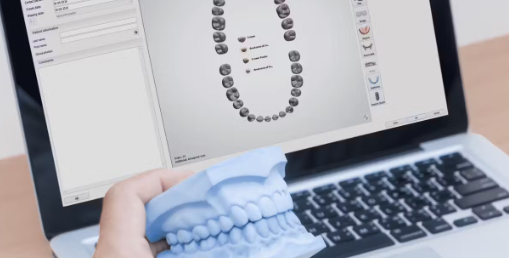Dental medical software can be divided into two categories: dental patient management software, which holds patients’ personal information and visit information, and dental treatment software, which is used for documenting and working with the patient’s treatment history and its planning. All programs from the second group can be classified as dental CAD/CAM software. Below, we will describe the most common types of dental software from this group.

Dental design software
This is a form of dental 3d modeling software that helps specialists in clinics and labs design crowns, dentures, bridges, and other restorations . These programs for instance help design restorations like crowns and bridges based on a digital impression. The rise of Artificial Intelligence makes these tools quicker and more accurate in the way they can automate the majority of the manual steps, so that only the finishing touch of a crown design needs the hands and eyes of a human expert. Another type of software that is worth mentioning is digital denture software: over the past couple of years, it has been shown possible to fully digitize the process of designing, planning and fabrication of partial and complete dentures. A third category of design software is digital smile design software. This type of software helps patient communication by combining photographs of the patient’s current teeth with a treatment plan, and in this way it can give a realistic visualization of the patient’s future smile, before treatment has even started.
dental design software
Dental treatment simulation software
This type of dental 3d software is not a design software, but a simulation tool that helps simulate step-by-step outcomes of orthodontic corrections and predict the position of the teeth after for example aligner treatment. In combination with orthodontic planning software, doctors can much more easily communicate about treatment possibilities, outcomes and give patients a step-by-step overview of what is to happen during their treatment. For patients, the transparency in the communication process and around treatment expectations will make treatment acceptance or rejection significantly easier.
Dental patient monitoring software
Software for monitoring enables dentists to see the changes in oral health over time. It is becoming more and more accepted to digitize patient records with the purpose of tracking the patient’s condition, so that the doctor can intervene before serious treatment is needed. This is also called preventative care. Scanning each patient every time can in this way help to detect early caries, tooth wear, grinding, chipping, and other changes invisible to the naked eye. Another benefit of this type of dental treatment software is how it can help educate patients so they get a better understanding of their oral health.
Dental patient engagement software
If you are a dentist and wondering how to improve patient experience in the dental office, then it might be worth implementing patient engagement software into your everyday practice. These solutions help to build stronger relationships with patients by engaging them in the treatment process. Imagine you can show them a before-after comparison. Or send them a treatment plan directly to their smartphones. Dental patient engagement is not only a trend — it’s a new way of communication that is only natural for younger patients. A generation that plays computer games and communicates via apps day-to-day expects this same level of engagement in every part of their lives.
Dental surgery software
Another type of software solution is implant planning software. Dental surgery software Dental surgery software helps doctors perform a prosthetic-driven implant planning workflow by designing the temporary or final restoration and the dental surgical guide software that will assist during implant placement. It can help with either fully guided or partially guided surgery. Plus, it will eliminate guesswork and increase clinician confidence and give predictable outcomes. The software can even generate automated design proposals for the prosthetic designs with the help of Artificial Intelligence. The clinician can edit these based on the patient’s needs and the doctor’s wishes. In this way, software is there to guide the doctor in every step of the process. In some cases, when the clinical situation allows, same-day implant placement is even possible (because the prosthetics can be printed on the spot). Studies showed that computer-guided surgeries help to achieve a better implant survival rate than operations performed without guided solutions .
Dental milling software
CAM software for milling is a type of dental clinic or dental laboratory software that is intended for manufacturing bridges, crowns, implant abutments, and other restorations for perfect fitting in the mouth. The milling software either works with imported CAD files and then instructs the mill to create the product in the right way, or alternatively, the design software can communicate with milling machines directly. Dentists can even choose to set up a dental CAD/CAM workflow in-house so they are not as dependent on their lab anymore: they take the digital impression, design the restoration with the dental design software, and produce via milling machines in a single day. This is what is called "same day dentistry" or "chairside dentistry".